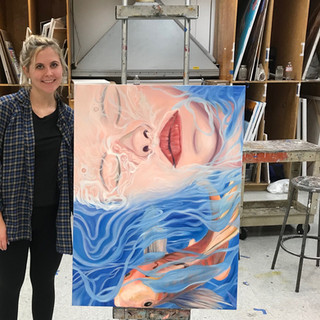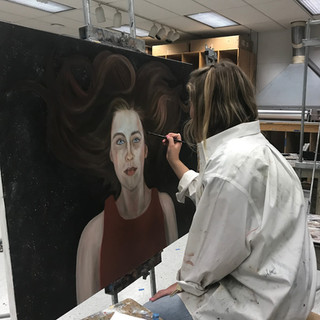Local Spotlight: A Conversation With Kat Conaton
- Francis Moran
- Feb 29, 2020
- 4 min read
How did you get involved in art?
Before coming to Georgetown, I didn’t have a lot of experience with painting. I had been involved with photography in high school, but I had no experience with oil painting, which has ended up being my concentration.
When I came to Georgetown, I took a sculpture class, and ended up quickly realizing it was too much for me. So then I decided to take an oil painting class. Almost instantly it clicked, and I found so much joy. Everyone says that it’s relaxing to paint, but for me it’s not. Instead, it gives me a space to be myself and I can have downtime and put my energy into something that I want to be successful.
What are your current inspirations, and what media are you typically using?
I’ll start with my “thing” I guess, which is portraits and painting people. It started with one painting of my brother, and then it evolved into wanting to paint the people around me. I wanted to paint people that I admired and respected in an interesting and new light. I think that there’s a lot to be said about portraits in the sense that you’re seeing something but you don’t actually know what’s going on. I wanted to delve into what’s going on behind the canvas, and I think that it’s exciting for the audience to try and figure out what’s going on in each setting. I’ve been really inspired by my family and friends, and I’ve wanted to tell stories.
I’ve been focused on oil paintings. I stick to cooler tones with my skin tones, and always try to bring in an aspect of surrealism. Ultimately, my vision for my works is to encompass this idea with juxtaposing portraits with the psychological. I want to play with what you see versus what is actually happening. I want my art to be an opportunity for people to question what exactly is going on for each subject.
On average, how long does a piece usually take?
Well, it depends on the piece and the canvas size. A piece around 30x40 inches will usually take me 20-30 hours.
What aspect of portraits do you find the hardest?
Some people say the eyes, but for me it usually ends up being the skin tone. I find it hard to get the right tones with highlights and shadows, so it usually takes me a bit of time to find the perfect palette
How has Georgetown or D.C. crafted your expertise?
I absolutely love the art department at Georgetown. I love the faculty. The professors have been so helpful in curating me as an artist and helping me to find what my art wants to become. I’ve been really lucky to have some really great mentors that have helped to shape me and guide me in what kind of art I want to be doing and how I want my visions to be portrayed.
But I know that Georgetown has so much space to grow, as with any program. Georgetown is not known for its art program, and that’s okay, but I do think that we would love to gain more exposure. We are mostly restricted in space especially in our number of classrooms and class offerings. For example, the graphic design department is gaining a lot of attraction because of the presence of the internet and media jobs. The skills gained in those classes are amazing, but they have really long waitlists.
You mentioned you had some great mentors while here. Is there anyone in particular that has really helped you hone your work? My professors, B.G. Muhn and Scott Hutchison, have both been so great to me. I’ve worked more with B.G. Muhn, but they’ve both helped me find my style. They’ve not only helped me with my ideas but also with life. B.G. Muhn just published another book about South Korean Art, yet I’m still able to get face to face
time with him, which is so valuable.
Do you think that there’s anything that Georgetown can do better for its artists?
Well, the most pressing issue right now is just a lack of space. I think that we have so many talented artists and we just don’t have enough room. Even [on the Walsh 2nd Floor], we are incredibly crowded and I don’t even have enough room to store my paintings. Just having more classes would be lovely, so waitlists aren’t so intense.
But in particular, more exposure. Despite being a prestigious university, our school just isn’t well known for our art program. Additional exposure will get so many more interesting people wanting to come and visit and become artists. Not many people even know that art majors have an art show. Even small things like featuring student pieces around campus would be really positive.
You mentioned your upcoming show in April, what are you hoping to do with that show?
As an studio art major, we are lucky enough to have a show where we submit pieces to a curator who helps select the strongest pieces. We’ll then have a display of our pieces in the new De la Cruz Gallery. Each artist will have their own artist statement and theme throughout our works. I hope to submit around 5-8 pieces that are all portraits between 30x40 inches to 36x48 inches.
In other regards, I’m not sure where my art will go beyond college, but I know that I’ll continue to paint. I want to take the time to look at people and be interested in others. I see myself continuing work portraits and spreading my love for art to everyone I know. I’m not sure where my art will take me, but I hope to continue experimenting and playing with different mediums and styles.
Finally, where can people find you?
People can find me on Instagram at @kat_conaton_art! Being a smaller artist, it’s a great way to communicate directly with my audience. I also have a website: kathleenconaton.com!
Or find me here at Walsh! Come paint with me!
Francis Moran
Photo Credit: Kat Conaton










